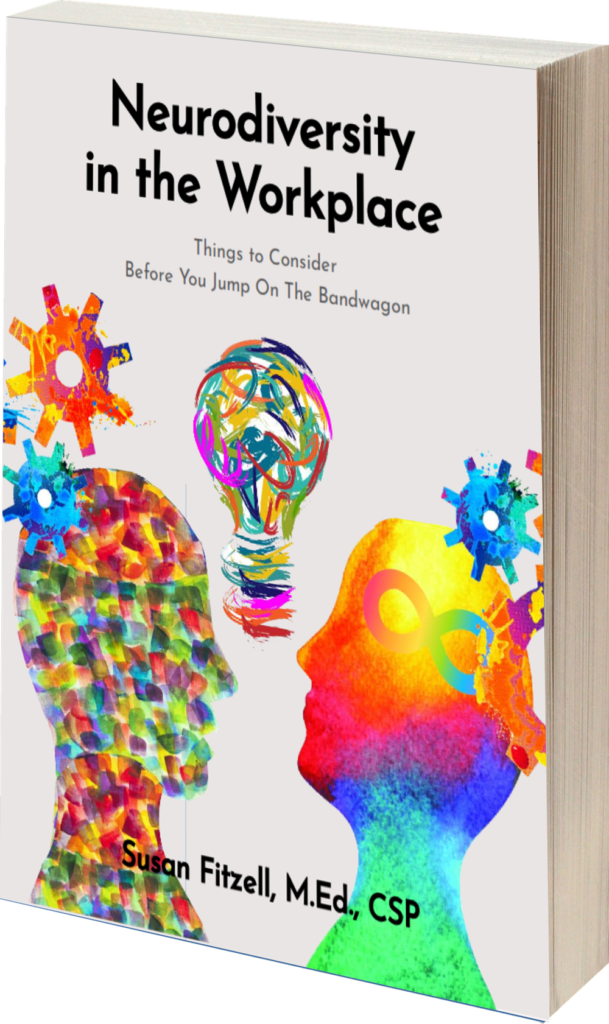
Does your team seem a little unfocused, less productive, or stressed out? Changing the rhythm of the workday can help employees feel recharged and better focused. A team-building exercise or another type of group activity can really help.
Team-building is essential, especially for neurodiverse employees who may have difficulty building a social rapport with their colleagues. But traditional team-building exercises can cause extra anxiety for neurodiverse teammates. Here are some group activities that can benefit everyone on the team.
Think/Pair/Share
- Add this exercise to meetings that run longer than usual or where much information is being imparted. Have employees think about the information you want them to process and understand for a few minutes. Then have them pair up (or even triple up) and share their thoughts about the information with each other. This is a social activity that enables both neurodiverse and neurotypical employees to speak with their peers without fear of judgment.
Tell a story, then discuss
- People remember stories — they are stored in long-term memory and can quickly be recalled. That’s why speakers frequently open their talk with a story because it engages the audience while making a point about the topic to be addressed. Because a story has a beginning, middle, and end, it creates a pattern the mind can follow. It also helps employees engage with the discussion once you’ve completed the story (or reached a point where discussion is helpful).
Pattern out problems and solutions
- Patterns are helpful for all employees, but especially for neurodiverse workers. It helps them associate concepts with visual images. Uncover all of the whiteboards in the meeting room. Set out colored markers and pencils. (If your team is meeting online, have everyone pull up OneNote, Google Docs, or another group-enabled app.) Discuss the problem at hand, and encourage colorful and artistic note-taking. Designs might include colored graphic organizers, grouping and classification charts, and sequence charts, including timelines and workflows.
Note: As the meeting leader, you may need to help start things by associating concepts with visual images. Include diagrams, tables, outlines, etc., when presenting new information to your neurodiverse team. After introducing new ideas, concepts, or challenges, ask the group to visualize how various statements relate to each other and draw a graph, chart, picture, or some other representation of the material.
Tongue twisters
- This is a great starting exercise to get everyone relaxed and focused. Tongue twisters increase the activity of brain cells in Broca’s area, which controls speech articulation. Create tongue twisters–they can be random, fun tongue twisters or designed to review material the team needs to remember. This exercise can be combined with the Think/Pair/Share exercise: Have a contest to see which team pair can come up with the best tongue twister! Not only will your team be laughing, but they will also remember critical information.
Structured virtual happy hour
- This is a variation of a popular “Zoom party” or happy hour. The difference is that it’s structured so neurodiverse employees can participate and socialize without struggling to connect. Set a date and time for the happy hour and where it will take place (online via Teams or Zoom or in person at the office). Include a structured schedule in the invite — what time it starts and ends, and key activities.
- One key activity in a structured happy hour is “getting to know you.” Before the event, send an email explaining that during this activity, each person will get to answer one or two pre-set questions about themselves. During the activity, assign one person to ask the questions of each participant. This structure gives neurodiverse employees time to prepare and think about their answers before the activity begins.
- Consider other supportive activities like combining Trivial Pursuit with a Think/Pair/Share — employees can support each other to come up with answers.
Meaningful involvement is important to every employee, both neurodiverse and neurotypical. Supportive group exercises that encourage workers to help each other learn and understand new information and that build a sense of camaraderie can make the workplace a positive environment. It can help stimulate creativity and improve productivity. And it can help employees build lasting connections with each other.
Photo Credit: innovatedcaptures /IStockphoto Standard License
Can you do me a favor before you go?
If you enjoyed this article, join my email list to access all of my free neurodiversity in the workplace guides, including my eBook “Neurodiversity in the Workplace; Things to consider before you jump on the bandwagon. ” (This link takes you to my website.)
Susan is a recognized authority in the learning and collaboration space. Her ‘lived experience’ as a neurodivergent, combined with her three-plus decades in the field of learning disabilities and neurodiversity, uniquely qualifies her as an expert in this field. Because she understands the struggles of someone whose brain is wired differently, she is passionate about creating a world that empowers and values neurodivergent talent.
Neurodiversity Definition
Neurodiversity: this term refers to a general diversity of minds. It includes people who are neurotypical and neurodivergent. When I talk about promoting neurodiversity in the workplace, for example, I am referring to creating a diverse workforce representative of the broad spectrum that exists when it comes to ways of thinking, processing information, communication, and learning. Some employees may be “normal” or neurotypical while others may have ADHD, Dyslexia, Autism, or trauma impacted ways of thinking. I am not referring to any particular label or diagnosis, but rather, the concept of an environment where a diversity of minds coexist.
Neurodiverse: This word is pretty much the same as neurodiversity, but should be used as an adjective. You can say, for example, that your workplace is neurodiverse.
Be careful though, because you should never describe a person as being neurodiverse. Individual people should be described as neurodivergent.
Neurodivergent: This word describes an individual whose way of thinking falls outside of society’s defined version of normal. Oftentimes you will see it abbreviated as ND.
Many times, neurodivergent people will have a diagnosis or label you may recognize, like autism, dyslexia, or ADHD. But neurodivergent people are also those with epilepsy, different kinds of brain trauma, or simply a unique way of thinking that may not have a specific diagnosis.
CLICK HERE to visit the articles page.
 FREE DOWNLOAD: Neurodiversity in the Workplace: Things to Consider Before You Jump On the Bandwagon
FREE DOWNLOAD: Neurodiversity in the Workplace: Things to Consider Before You Jump On the Bandwagon
Neurodiverse hiring practices can benefit any company in any industry and in more areas than most people realize. The investment has yielded greater patenting, innovation, process improvement, efficiency, and creativity not only in technology industries but also in industries that include investment banking, insurance, and mortgage banking.
This resource explains the term “neurodiversity” and describes the potential positive impact on your business that can come from including neurodivergent individuals in your workplace.
Download Neurodiversity in the Workplace! – Free!
Bring Susan Fitzell, M.Ed., CSP
Top Neurodiversity Speaker
To YOUR Organization!

